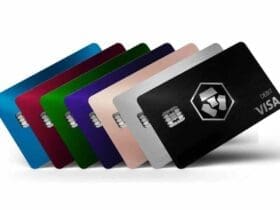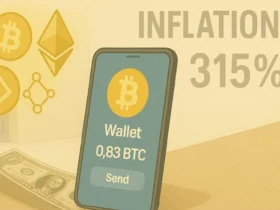In this article, I will talk about the process of depositing cryptocurrency into a cross-chain wallet, covering the most secure and effective methods. Cross-chain wallets enable one to oversee several digital currencies from different blockchains in a single interface.
I will guide you through the most important steps, strategies, and measures to guarantee the safety of your deposits. Even if you are a beginner, you will be able to navigate multi-chain wallets easily.
What is a Cross-Chain Wallet?
A cross-chain wallet is a type of cryptocurrency wallet that enables users to interact with multiple blockchain networks, letting them store, send, and receive tokens through a unified interface.
Unlike traditional wallets that are limited to one blockchain, cross-chain wallets provide interoperability and make it easier to manage a range of assets.
Multi-chain address generation, token swaps, and connection to DeFi ecosystems are some of the functionalities offered by cross-chain wallets.
Consolidating assets across different blockchains enhances portfolio management, reduces the number of wallets required to store assets, and increases the user’s flexibility when securely trading and transferring cryptocurrency across networks.
How To Deposit Crypto Into a Cross-Chain Wallet
Example: Depositing Crypto Into Trust Wallet (Cross-Chain Wallet)

Download and Set Up Trust Wallet
- Access the official website or app store to download Trust Wallet.
- Set up a new wallet and remember to back up the recovery phrase.
Select the Cryptocurrency to Deposit
- Open the wallet and click on “Receive.”
- Select the token you wish to deposit (USDT, BNB, BTC, etc.).
Copy the Deposit Address
- The wallet will display a unique address for the selected token.
- Ensure you verify the selected network for cross compatibility.
Send Crypto From an Exchange or Another Wallet
- Go to the platform you wish to send crypto from and paste the copied wallet address.
- Confirm the network, enter the amount you wish to send, and click send.
Wait for Confirmation
- After the deposit address is verified, the transaction will be processed.
- You can see the transaction status from your wallet and from the blockchain.
Key Features Deposit Crypto Into a Cross-Chain Wallet

Multi-Blockchain Support
Support for deposits from multiple blockchains like Ethereum, Binance Smart Chain, or Solana all in one wallet.
Unique Wallet Addresses per Token/Chain
Ensures each token on different chains is sent to the correct address to avoid losses.
Seamless Token Transfers
Direct deposits from exchanges or other wallets are allowed without needing to convert first.
Low-Risk Deposit Verification
Deposit verification processes show transaction confirmations and the blockchain’s current status.
Cross-Chain Interoperability
Moving assets over different chains is enabled via bridges or integrated swaps.
Security Features
Safekeeping of deposits includes private key management, recovery phrases, and optional 2FA.
Transaction History & Tracking
Users are able to monitor the status of their deposits, confirmations, and transactions within the wallet.
Test Transfer Option
Small deposits can be done on some wallets to avoid making errors on larger transfers.
Prerequisites Before Depositing Crypto
Gathering a cross-chain wallet Prior to depositing cryptocurrency, ensure that your cross-chain wallet is configured, installed, and is ready for seamless multi-asset management.
Confirming supported blockchains and tokens Look into the blockchains and cryptocurrencies supported by your wallet to avoid sending unsupported tokens which can result in permanent loss.
Checking wallet address functionality Confirm that the deposit address is the appropriate token and blockchain network pair to avoid failed, or costly, fund loss.
Understanding network fees and block time Have a clear understanding of the charges associated with transactions and the confirmation time which can affect both speed and cost.
Backing up wallet and private keys Backing up the private keys or recovery phrase associated with the wallet ensures that the funds cannot be accessed irreversibly.
Common Mistakes to Avoid
Sending crypto to the wrong blockchain address Sending crypto to the wrong blockchain address is a problem. Failing to assess the network your wallet operates on could make you lose your crypto.
Ignoring network fees or minimum deposit requirements These oversights could lead to underfunded crypto addresses, which would either lead to complete transactional failure or, in some cases, the transaction would result in only a portion of funds getting deposited, which would be a loss.
Not double-checking wallet addresses While it is relatively common, it is important to remember that crypto addresses must be verified twice before being spent.
Forgetting to back up private keys or recovery phrases If a device or wallet app is lost and there isn’t a backup, then accessing the crypto would be impossible.
Tips for a Safe Crypto Deposit

Only utilize official wallet applications and sites Ensure wallets are downloaded to verified sites to eliminate the risk of phishing apps and scams that compromise your funds.
Activate 2FA and other security options Two-factor identification and other additional security options fortify your wallet from security breaches and unauthorized access.
If the deposit is large, do it in phases, starting with a nominal test deposit Testing a small deposit first helps confirm the address and network, avoiding costly mistakes for large deposits.
Always implement all fee updates and app revisions immediatel Consistent updates address security gaps and bolster wallet functions, safeguarding crypto transactions.
Pros And Cons
| Pros | Cons |
|---|---|
| Supports multiple blockchains, allowing management of various cryptocurrencies in one wallet. | Mistakes in selecting the wrong network can lead to permanent loss of funds. |
| Simplifies portfolio management with all tokens in a single interface. | Some wallets may charge higher network fees for certain blockchains. |
| Enables cross-chain transfers and token swaps without needing multiple wallets. | Can be complex for beginners unfamiliar with blockchain networks and addresses. |
| Provides secure storage with private keys, recovery phrases, and optional 2FA. | Deposits may take longer depending on blockchain congestion and confirmation times. |
| Test deposits allow safe transfers before sending large amounts. | Not all tokens or chains are supported by every cross-chain wallet. |
Conclusion
To finish, depositing crypto in a cross-chain wallet is easy if you take the right approach. Confirm wallet compatibility with the token and network, re-verify addresses, understand fees, and safeguard private keys. Ensuring a test deposit first improves safety.
Following these practices allows users to securely manage and transfer crypto across blockchains with assurance.
FAQ
Copy your wallet’s deposit address, select the correct network, and send crypto from an exchange or another wallet.
Only deposit tokens supported by your wallet and blockchain network.
Transaction times depend on the blockchain and network congestion.














Got a Questions?
Find us on Socials or Contact us and we’ll get back to you as soon as possible.